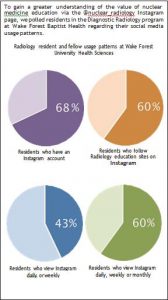Nuclear medicine education via the social media site Instagram

Social media plays a prominent part in the general public’s daily routine and primary information source on topics ranging from politics to medicine, regardless of occupation. In this article, the medical professional population is our primary interest. One recent study found that up to 94% of medical students, 79% of residents, and 42% of practicing physicians use social media [1], making it an ideal platform for integrating education into the medical professional’s daily routine.
Since nuclear medicine is a visually oriented profession, social media sites that allow for image and video content such as Twitter, Instagram, and Facebook can be valuable educational tools. Because of their ubiquitous use, hierarchical/vertical educational barriers are diminished. For example, students, technologists, residents, and practicing physicians can all access the sites. Other educational barriers are decreased as well: people worldwide can participate and web-based computer translation systems have helped ease language issues. In addition, social media sites by definition are interactive, allowing for comments and questions from learners and teachers.
In an effort to reach learners of nuclear medicine on social media sites, the Instagram page@nuclear_radiology was created in 2016. Posts focus on interpretive skills for nuclear medicine and PET, nuclear medicine and radiology board preparation, and quality control/artifact identification. The site currently has over 6000 followers and has high levels of user interaction with posts (approximately 150 to 300 likes per post). This site joins several radiology- based educational accounts that are available to users on Instagram and Twitter, including:
@thexraydoctor
@nuclear_radiology
@dr_nuclear
@Cincykidsrad
@Arrs_radiology
@Radiologyacr
@Radiopaedia
Example Cases
Some of the downsides of using social media for medical education include lack of peer review





inefficient teaching methods, and a bias in academia against social media since it is often used for seemingly frivolous pursuits (popularity, narcissism, too much information/skin). Future directions for improving medical education on social media sites include:
- Incorporating more evidence-based medicine: Studies demonstrate improved learning when directly comparing normal cases to abnormal cases in a side-by-side manner. Similarly, there is evidence for improved learning when comparing multiple different case examples of a similar abnormality [2].
- Analyzing engagement: Incorporating analysis that directly records/measures forms of engagement on Instagram such as Hootsuite or Instract determine what types of posts stimulate the most
- Utilizing follow-up posts to reinforce teaching points by spaced repetition learning
- Exploring connections to Facebook, Twitter, and companion websites by maximizing the efficient use of the hashtag and biography page of Instagram
As we all know, social media already functions to distribute information on a large scale, potentially making it a useful and previously underutilized supplemental tool for educators. Instagram can be a means of providing case-based visual learning that is readily accessible by technology-savvy students, trainees and professionals. Hope to see you there!
References
- Shah, V., Kotsenas, (2017). Social Media Tips to Enhance Medical Education https://doi.org/10.1016/j.acra.2016.12.023
- Kok, M., de Bruin, A. B., Leppink, J., van Merrienboer, J. J. G., Robben, S.G.F. (2015).
Case Comparisons: An Efficient Way of Learning Radiololgy. http://dx.doi.org/10.1016/j.acra.2015.04.012

Editor’s note: This is part two of multiple articles exploring social media and healthcare. In the next issue: Practice development via social media.



